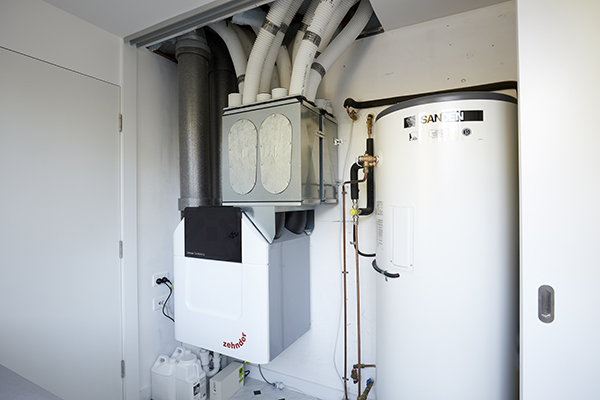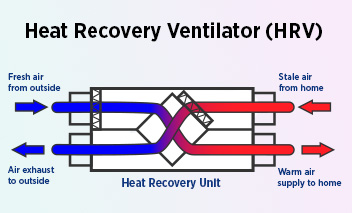Quick Guide: What to Consider Before Buying HRV
The All-Inclusive Guide to the Uses of Heat Recovery Ventilation in Modern Structures
Heat Recovery Ventilation (HRV) systems represent a substantial advancement in building modern technology (HRV Heat Recovery Ventilation). They supply an approach for trading stagnant interior air with fresh outdoor air while lessening energy loss. This method not only improves interior air top quality however likewise contributes to energy effectiveness in both household and industrial buildings. Understanding the various applications and advantages of HRV can reveal its crucial function in contemporary style and sustainability initiatives. The ramifications of this technology are worth discovering additionally
Comprehending Heat Recovery Ventilation Equipments

Although lots of contemporary buildings prioritize energy performance, comprehending warmth recovery air flow (HRV) systems is vital for enhancing indoor air quality and minimizing energy intake. HRV systems function by transferring warm from stale interior air to incoming fresh air, effectively keeping comfy indoor temperatures while reducing power loss. These systems include a warmth exchanger, followers, and ductwork that assist in the flow of air. Throughout winter, HRV systems catch and reuse warm from the outgoing air, while in summertime, they can aid cool incoming air. By continually trading air, HRV systems additionally lower moisture and the focus of interior toxins. Proper installation and upkeep of HRV systems are vital for their efficiency and performance in improving general building performance and convenience.
Advantages of Heat Recovery Ventilation
Heat recovery ventilation systems offer numerous advantages that boost both energy performance and interior air quality in modern-day structures. By recording and reusing power from exhaust air, these systems substantially lower cooling and heating expenses, bring about lower power consumption. They keep a consistent circulation of fresh outdoor air, decreasing the threat of interior air toxins and irritants. This constant exchange helps regulate humidity degrees, protecting against mold development and making certain a healthier living setting. In addition, HRV systems add to sustainability objectives by decreasing total carbon footprints. Their ability to enhance ventilation without compromising thermal comfort makes them a valuable enhancement to modern structure design, advertising both economic and environmental advantages.
Applications of HRV in Residential Structures
As house owners significantly focus on energy efficiency and indoor air high quality, the applications of warmth healing ventilation (HRV) systems in residential buildings have actually become a lot more prevalent. HRV systems are specifically useful in securely sealed homes, where keeping fresh air blood circulation is essential for stopping wetness buildup and interior toxins. They efficiently transfer warmth from outbound stale air to inbound fresh air, lowering energy prices connected with heating and cooling. Additionally, HRVs can enhance comfort degrees by managing humidity and temperature level. They are additionally adaptable for various domestic styles, consisting of single-family homes and multi-unit buildings. Overall, integrating HRV systems supports sustainable living techniques while ensuring a much healthier interior environment for passengers.
HRV in Industrial and Industrial Settings
In commercial and commercial settings, the application of warmth recuperation why not find out more ventilation (HRV) systems has actually come to be progressively important for maximizing energy effectiveness and preserving air high quality. These systems effectively move warmth from exhaust air to inbound fresh air, reducing the need for additional heating or cooling. This not just lowers energy expenses but additionally adds to sustainability efforts. Industries such as manufacturing, warehousing, and workplace buildings profit substantially from HRV systems, as they aid control temperature and humidity degrees, ensuring a comfortable and productive environment. Moreover, HRV systems aid in eliminating impurities and excess wetness, enhancing interior air high quality. As laws around air high quality come to be advice stricter, the fostering of HRV technology is likely to grow, making it a crucial component of contemporary business and industrial framework.
Future Fads in Heat Recovery Ventilation Innovation

Often Asked Inquiries
Just How Does Heat Recovery Ventilation Influence Indoor Air Quality?
Heat recovery ventilation considerably improves indoor air high quality by continuously trading stale indoor air with fresh exterior air while recovering power. This procedure minimizes toxins, preserves optimal moisture levels, and ensures a healthier setting for passengers.
Can HRV Equipments Be Mounted in Existing Buildings?
HRV systems can without a doubt be set up in existing structures. Retrofitting may require modifications site web to ductwork and air flow layouts, however it significantly boosts power effectiveness and indoor air high quality, making it a viable option for older structures.
What Upkeep Is Needed for HRV Solutions?

Exist Specific Climates Where HRV Is Much More Efficient?
Heat recovery ventilation systems are especially reliable in climates with considerable temperature level differences in between seasons. These systems enhance energy effectiveness by recouping heat from exhaust air, making them optimal for both cold and moderately warm atmospheres.
Exactly How Do HRV Systems Affect Energy Costs?
